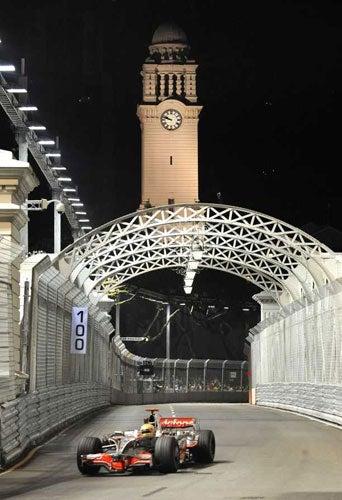Ecclestone revels in F1 night fever
Staging race under lights lets Europe watch in prime time and pleases sponsors

In motor racing terms night races are nothing new, but from the Formula One perspective running the inaugural Singapore Grand Prix under floodlights will allow the commercial rights holder Bernie Ecclestone not just to have his cake and eat it, but also to enjoy the nice cherry on top.
Endurance sportscar races have always run through darkness and light – the late François Cevert even set a new lap record for Matra in the night during the famed Le Mans 24 Hours in 1972, without recourse to the barrage of lighting gantries that subsequently featured when America's Indy Racing League (IRL) and Nascar series first organised their oval night races in the Nineties.
Traditionally, the Formula One powers-that-be have shied away from anything that might seem remotely reminiscent of Uncle Sam's domestic series – apart from pit stops and safety cars, of course – but there are many wholly practical reasons behind Ecclestone's idea to make the inaugural Singapore Grand Prix a race run under artificial light. He and the Singaporean property billionaire Ong Beng Seng had been discussing the possibility of holding a race under floodlights in the south-east Asian city state for several years.
All Formula One sponsorship is about exposure for a given brand, with the European market being crucial. But "flyaway" races are either run hours ahead of – as in the case of Malaysia, Japan, China, Singapore and Australia – or behind – as in Canada, America and Brazil – European time zones. Staging a night race, however, at a stroke puts Singapore's inaugural event back into Europe's prime time.
Formula One has begun a progressive move away from its traditional European base in recent years, but the flipside has been the time differences. By racing at night in Singapore, Ecclestone has been able to ensure European audiences can watch the race at the same time they normally watch European races, thus giving sponsors a better return on their investment. The sponsors are pleased, the hard core of Formula One's fans are pleased, teams are pleased – and that means Mr E is pleased too.
"I do hope that people have now changed their idea that this is a stupid idea," Ecclestone said yesterday. The mood here thus far suggests that there are few who think that, though there were a few who were doubtful initially.
Back in March, the former champion Fernando Alonso came out strongly against night races. "I think, for me, it is impossible," the Spaniard said. "I think there is a huge safety issue racing in the streets.
"We are trying to develop tracks to make racing safer. We are changing corners in Barcelona for safety reasons and now we want to go to the streets. Something is going wrong here. Racing at night requires a huge amount of light.
"No one has thought that something might happen if the lights go out. It is not a football match. I think there are many, many things to sort out before night racing becomes a reality."
His former Renault team-mate Heikki Kovalainen, now Lewis Hamilton's partner at McLaren, said: "It's not quite like a football game: if the lights go off we can't just stop and see how it's going, so that obviously could be very dangerous, but I think it's been very well taken care of. Hopefully."
"Yeah, it's obvious: if the lights go off, we're in trouble," Red Bull's Mark Webber said. "But I think we're in good shape that that doesn't happen. Hopefully, touch wood."
Thus far the meeting has been an object lesson in problem solving, and demonstrating how to run a major event in a big city. "We are never likely to get the World Cup or the Olympics, so we need to understand our limitations and the grand prix is perfect for us," said Jonathan Hallett, media and communications director, Singapore GP Pte Ltd.
"This is going to be the most major event in the city. The timing has been the most challenging aspect, and we started a year ago. The other big thing is that this is a living, breathing city, and it is funding the project to the tune of 60 per cent, to showcase Singapore. That's why, obviously, it has to run by familiar monuments and landmarks.
"The planning and logistics of how we were going to build the track without disrupting commerce was something we had to consider very carefully. As you can see, where the track runs is right in the middle of all the office blocks and they are always very busy."
Subscribe to Independent Premium to bookmark this article
Want to bookmark your favourite articles and stories to read or reference later? Start your Independent Premium subscription today.

Join our commenting forum
Join thought-provoking conversations, follow other Independent readers and see their replies